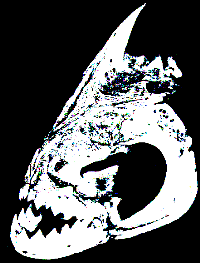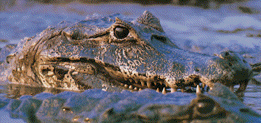There is a special custom in the frequently flooded woodland and wet savannah zone of the Orinoco. In these regions, where burial of the dead is impossible during the many months of the year because of the flood waters, the piranhas or "caribe" are assigned a cultural-mythical role as undertakers. The Guarani Natives for instance, wrap their dead tightly in nets of coarse mesh and let the piranhas, which occur there in large numbers, prepare the bodies for the actual funeral. When the piranhas have removed all the flesh from the bones, the nets are taken out of the water. The skeletons are then dried, sometimes colored with the red juice of the onoto plant, and adorned with all kinds of feathers. Finally they are given a place of honor in a high-lying spot or in the gable of a pole-and-thatch hut.


In South America there is a widely held belief that a bowl of piranha-head soup is an aphrodisiac.
One of the biggest myths is of caddle herdsmen sacrificing a sickly cow to the piranhas so that the others can cross the river unharmed. This isnt true at all, not that it isnt impossible for a large number of piranha to reduce a cow to a skeleton, but that the caddle herdsmen are too poor and cant afford to sacrifice any animals just to ford a river.
Among the most interesting piranha hunters, however, are undoubtedly the freshwater dolphins or "boto" that have evolved in the tropical Amazon and Orinoco, there are 2 colors of this dolphin, black and pink, each a different species. It is a piranha gourmet, almost specializing in eating them. Next to humans, these dolphins are major predators of fish.
Unlike the teeth of the sharks, the dentition of the piranhas is not designed for lacerating, crushing, mangling, or holding prey; they are more implements for snipping, or clipping neat sections of flesh from an organism, rendering the prey into small, bite-sized, swallowable pieces. Unlike the teeth of sharks, which are arranged in rows that move up and succeed each other on "the front line" as wear or damage removes their effectiveness, piranha teeth are set in the short, broad jaws in a single row. These are sharper than sharks teeth and their mechanics remind one of the design and operation of a bear trap, in that when the piranha's jaws snap shut, the points of the teeth in the upper row fit neatly into the notches of those in the lower row.
Indeed, although the mouth of even a large piranha is relatively small in relation to the
overall size of the fish, the average bite would neatly excise a piece of flesh the size of a large olive. That may not seem like much of a mouthful, but when one considers the piranha's rapid-fire method of snap, swallow, and return for more, the idea of a prey animal disappearing within minutes under the combined assault of a large school of piranhas is not difficult to visualize!
The strength and power of the piranhas bite comes from the extremely deep and powerful lower jaw of the more dangerous species. The muscle mass and their attachments are very dense and provide the fish with the legendary cutting power.


